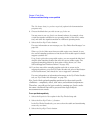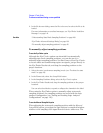
55
Chapter 2: Task Guide
To select transitional timing or store qualified
1. In the Sampling tab, select the Timing Zoom button.
2. In the Timing Zoom controls dialog, select the On/Off checkbox.
To set the Timing Zoom trigger position
1. In the Sampling tab, select the Timing Zoom button.
2. In the Timing Zoom controls dialog, select the trigger position.
Specify whether you want to look at Timing Zoom data after the trigger
(Start), before and after the trigger (Center), before the trigger (End), or
use a percentage of the logic analyzer's memory for data after the trigger
(User Defined).
NOTE: When in 333 MHz State mode (16717,18,19), the 400 MHz State mode
(16750,51,52), or the 600 MHz State mode (16753, 54, 55, 56), the start of
Timing Zoom data may occur after the actual trigger point. The reason for this
data mis-alignment is due to how the trigger sequencer functions when in this
mode.
The analyzer sequencer works on Pairs of samples. It will not evaluate the
first sample of the pair until the second sample has entered the sequencer. If
for example the trigger point is determined to be on the first sample, the
analyzer displays the Timing Zoom data relative to the evaluation of the
second sample. What ever time difference is seen between the two samples
(of the pair) is reflected in the data display between the trigger point and the
start of the Timing Zoom data.
This time difference can be noticeable if your measurement is using bursted
clocks and the first sample (actual trigger point) is clocked on the last clock
signal of a burst, and the second sample (of the pair) is clocked with the first
clock of the next burst. The time difference between the clock bursts is
reflected as a mis-alignment between the trigger point and the start of the
Timing Zoom data.
The best thing to do to help mitigate this situation is to set the Timing Zoom to
"Trigger Position End" to capture as much data near the first sample as
possible.


















